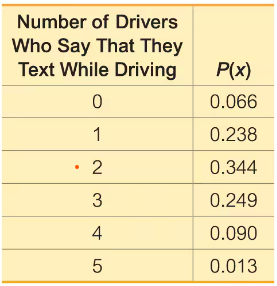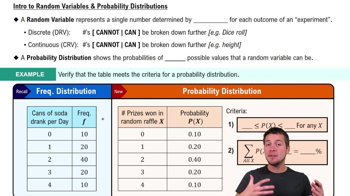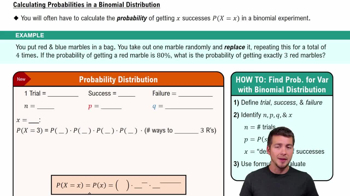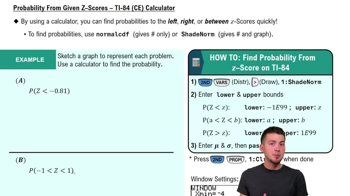National surveys indicate that 36% of people have been in a car accident in the last 5 years. If you randomly sample 10 people, how likely is that exactly 4 have had an accident in the last 5 years?
Table of contents
- 1. Intro to Stats and Collecting Data1h 14m
- 2. Describing Data with Tables and Graphs1h 55m
- 3. Describing Data Numerically2h 5m
- 4. Probability2h 16m
- 5. Binomial Distribution & Discrete Random Variables3h 6m
- 6. Normal Distribution and Continuous Random Variables2h 11m
- 7. Sampling Distributions & Confidence Intervals: Mean3h 23m
- Sampling Distribution of the Sample Mean and Central Limit Theorem19m
- Distribution of Sample Mean - Excel23m
- Introduction to Confidence Intervals15m
- Confidence Intervals for Population Mean1h 18m
- Determining the Minimum Sample Size Required12m
- Finding Probabilities and T Critical Values - Excel28m
- Confidence Intervals for Population Means - Excel25m
- 8. Sampling Distributions & Confidence Intervals: Proportion1h 12m
- 9. Hypothesis Testing for One Sample3h 29m
- 10. Hypothesis Testing for Two Samples4h 50m
- Two Proportions1h 13m
- Two Proportions Hypothesis Test - Excel28m
- Two Means - Unknown, Unequal Variance1h 3m
- Two Means - Unknown Variances Hypothesis Test - Excel12m
- Two Means - Unknown, Equal Variance15m
- Two Means - Unknown, Equal Variances Hypothesis Test - Excel9m
- Two Means - Known Variance12m
- Two Means - Sigma Known Hypothesis Test - Excel21m
- Two Means - Matched Pairs (Dependent Samples)42m
- Matched Pairs Hypothesis Test - Excel12m
- 11. Correlation1h 6m
- 12. Regression1h 50m
- 13. Chi-Square Tests & Goodness of Fit1h 57m
- 14. ANOVA1h 57m
5. Binomial Distribution & Discrete Random Variables
Binomial Distribution
Problem 5.1.24
Textbook Question
Texting and Driving. In Exercises 21–26, refer to the accompanying table, which describes probabilities for groups of five drivers. The random variable x is the number of drivers in a group who say that they text while driving (based on data from an Arity survey of drivers).

Using Probabilities for Significant Events
a. Find the probability of getting exactly 3 drivers who say that they text while driving.
 Verified step by step guidance
Verified step by step guidance1
Step 1: Understand the problem. The random variable x represents the number of drivers in a group of five who say they text while driving. The table provides the probabilities P(x) for each possible value of x (from 0 to 5). We are tasked with finding the probability of exactly 3 drivers who say they text while driving.
Step 2: Locate the relevant probability in the table. To find the probability of exactly 3 drivers, look for the row where the number of drivers is 3. The corresponding probability P(3) is provided in the table.
Step 3: Interpret the table. From the table, the probability P(3) is listed as 0.249. This value represents the likelihood of having exactly 3 drivers in the group who text while driving.
Step 4: Verify the context. Ensure that the table is based on valid data and that the probabilities sum to 1, as this confirms the table represents a valid probability distribution.
Step 5: Conclude the process. The probability of getting exactly 3 drivers who say they text while driving is directly obtained from the table as P(3). No further calculations are needed since the value is explicitly provided.
 Verified video answer for a similar problem:
Verified video answer for a similar problem:This video solution was recommended by our tutors as helpful for the problem above
Video duration:
3mPlay a video:
Was this helpful?
Key Concepts
Here are the essential concepts you must grasp in order to answer the question correctly.
Random Variable
A random variable is a numerical outcome of a random phenomenon. In this context, the random variable x represents the number of drivers in a group of five who report texting while driving. Understanding random variables is crucial for analyzing probabilities and making inferences about the data collected.
Recommended video:
Guided course

Intro to Random Variables & Probability Distributions
Probability Distribution
A probability distribution describes how probabilities are assigned to each possible value of a random variable. The table provided shows the probability distribution for the random variable x, indicating the likelihood of 0 to 5 drivers texting while driving. This distribution is essential for calculating specific probabilities, such as the probability of exactly 3 drivers texting.
Recommended video:
Guided course

Calculating Probabilities in a Binomial Distribution
Calculating Probabilities
Calculating probabilities involves determining the likelihood of a specific event occurring based on the probability distribution. For this question, to find the probability of exactly 3 drivers texting while driving, one would refer to the table and identify the corresponding P(x) value, which is 0.249. This process is fundamental in statistics for making predictions and decisions based on data.
Recommended video:
Guided course

Probability From Given Z-Scores - TI-84 (CE) Calculator

 6:00m
6:00mWatch next
Master The Binomial Experiment with a bite sized video explanation from Patrick
Start learningRelated Videos
Related Practice
Multiple Choice
